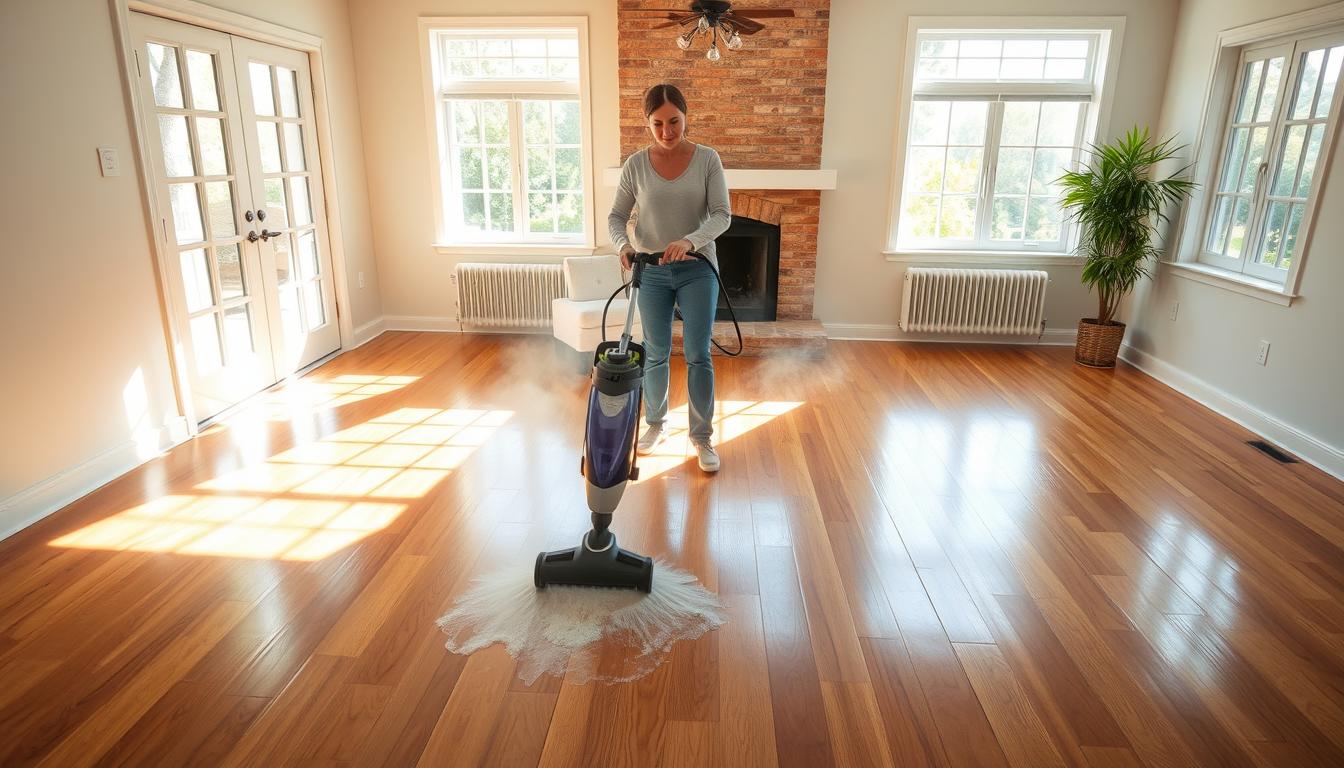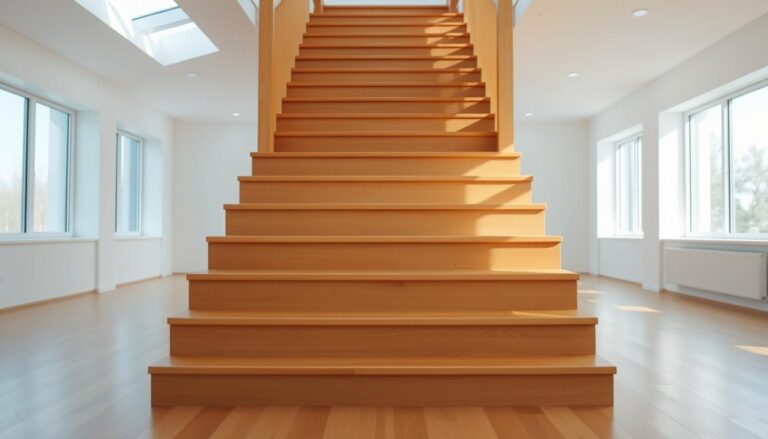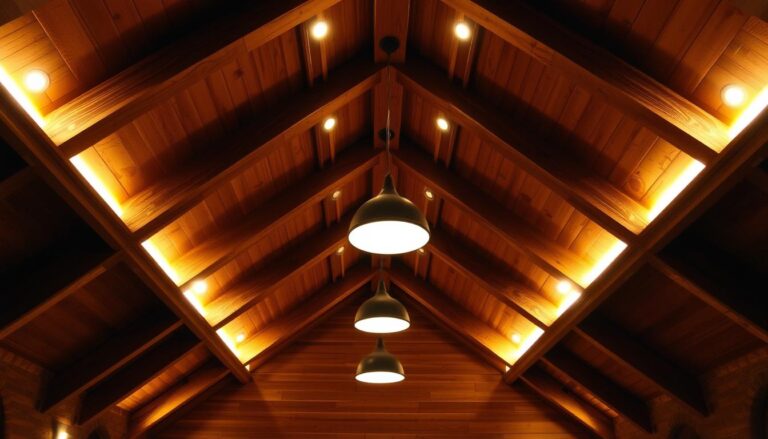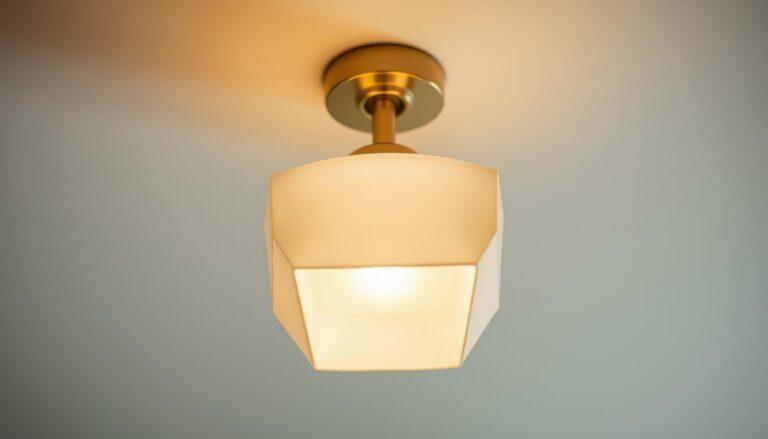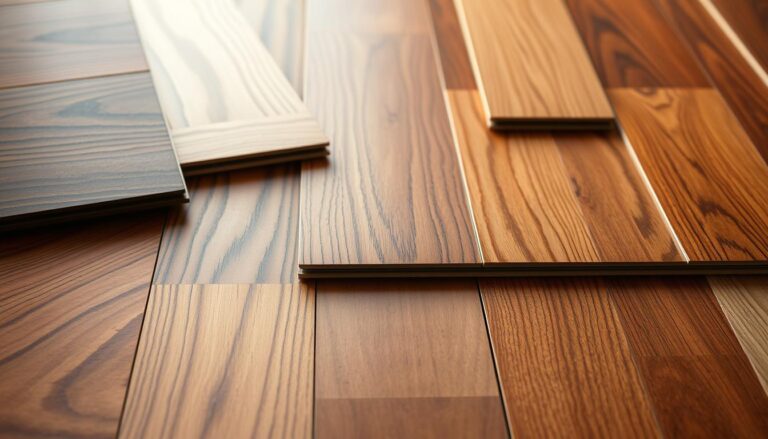Can You Steam Clean Hardwood Floors? The Truth Revealed!
Is steam cleaning safe for your hardwood floors, or is it a myth? Many homeowners are unsure if steam cleaning can harm their floors. This article aims to clear up the confusion and tell you the truth.
Hardwood floors are both beautiful and durable. But, some people are hesitant to use steam cleaning because of mixed advice. Does steam cleaning really damage hardwood floors, or is it safe? We’ll dive into the science behind steam cleaning’s effects and how it varies based on moisture and wood type.
Key Takeaways
- Steam cleaning’s safety depends on hardwood type and moisture control.
- Manufacturers often warn against steam use, but some professionals approve it under certain conditions.
- Sealed floors may tolerate steam better than unsealed ones.
- Alternatives exist for those avoiding steam entirely.
- Overuse of steam can lead to warping or finish damage.
Understanding Hardwood Floors and Their Sensitivity
Hardwood floors come in many types and need special care. Can you steam clean hardwood floors? It depends on their structure. Knowing the types like oak, maple, and cherry is key. Each reacts differently to moisture and heat.
Solid wood stays porous, even after finishing. Engineered wood has layers of wood veneers over a core.
Different Types of Hardwood Flooring
- Oak: Durable but absorbs moisture easily
- Maple: Harder surface resists scratches but can warp when wet
- Engineered Wood: Layers reduce warping risk but depend on top veneer quality
What Makes Hardwood Floors Vulnerable to Moisture
Wood fibers expand when wet, causing buckling or cupping. High steam temperatures can soften finishes, letting water seep into gaps. This can lead to risks of steam cleaning hardwood floors like mold growth in unseen joints.
Unsealed floors face higher dangers, while sealed ones resist but aren’t immune.
The Structure of Hardwood Floors: Sealed vs. Unsealed
| Feature | Sealed Floors | Unsealed Floors |
|---|---|---|
| Moisture Resistance | Protected by polyurethane or oil-based coatings | Exposed wood absorbs water easily |
| Steam Cleaning Suitability | Potential if finish is intact | High risk of warping or damage |
Always check finish age: worn sealants increase the risks of steam cleaning hardwood floors. Opt for low-moisture methods unless certified by brands like Bona or Armstrong.
Can You Steam Clean Hardwood Floors? The Direct Answer
The question can you steam clean hardwood floors has a nuanced answer. The National Wood Flooring Association warns against traditional steam cleaning because of moisture risks. Most manufacturers also advise against high-heat steam methods. They say it can damage finishes or seals over time.
However, the is steam cleaning good or bad for hardwood floors debate depends on details:
- Floor type (sealed vs. unsealed)
- Steam cleaner settings
- Current finish condition
Modern low-moisture systems rated under 250°F might be okay for sealed engineered hardwood in small, controlled areas. But unsealed or older floors are still at high risk.
“Steam cleaning isn’t universally prohibited, but it requires precise execution to avoid swelling, warping, or finish deterioration.” — NWFA Flooring Care Guidelines
Always check manufacturer warranties: many void coverage if steam cleaners caused damage. This can you steam clean hardwood floors dilemma shows the need for caution. It’s best to get a professional evaluation before trying steam-based cleaning.
How Steam Cleaners Work on Floor Surfaces
Steam cleaning for hardwood floors uses the right amount of heat and moisture. It turns water into steam, which loosens dirt without using harsh chemicals. Let’s look at what makes it work well and what risks there are.
The Science Behind Steam Cleaning
Steam cleaners heat water to 200–245°F. This heat breaks down dirt. The steam’s power softens stains, and the leftover moisture dries fast. But, if the wood stays wet too long, it can get damaged.
Temperature and Moisture Levels
- Most models operate at 200–245°F to sanitize surfaces
- Moisture output varies: some mops emit 5–10% water by volume
The best steam mops for hardwood floors aim to use less moisture. A 2022 study by the National Wood Flooring Association found that too much heat can cause warping. This happens if the wood stays wet for more than 5 seconds.
Penetration Depth of Steam on Wood Surfaces
How deep steam goes into wood depends on:
- Exposure time: 3 seconds or less reduces penetration to 0.1–0.5mm
- Finish type: Factory-sealed floors resist steam better than unsealed wood
- Wood density: Oak resists moisture better than pine
“Proper heat management is critical—overheating can degrade wood cell structure even without visible damage.” – Flooring Institute Report, 2023
Knowing how steam cleaning works helps keep your floors clean and safe. Always check the product specs for the best steam mops for hardwood floors (tested & reviewed). This ensures they’re right for your floor.
Potential Benefits of Steam Cleaning Hardwood
Steam cleaning is a chemical-free way to sanitize hardwood floors. It’s great for those who want to avoid harsh chemicals. This method can kill 99.9% of bacteria and dust mites, making it perfect for eco-friendly homes.
Allergy sufferers also benefit from this method. It reduces allergens without leaving any chemical residue behind.
The best way to steam clean hardwood floors is to use low moisture settings. This prevents the floors from getting too wet. It helps loosen dirt and grime without harming the finish.
Steam cleaning also makes floors shine again. It does this without the need for harsh scrubbing.
Steam cleaning is quick, often cutting down cleaning time by 40%. But, it’s important to use the right equipment. Models like Bissell or Steamoid work well for hardwood floors. They have adjustable steam output.
Swiffer suggests drying floors for 15 minutes after cleaning. This helps prevent warping.
Studies show steam cleaning reduces chemical exposure by 80% compared to spray cleaners. But, it’s important to use it correctly. Improper use can damage the floors. The National Wood Flooring Association recommends testing on small areas first.
The Risks of Steam Cleaning Wood Floors
Steam cleaning is easy, but it comes with risks of steam cleaning hardwood floors. Too much water can get into tiny gaps in wood, even if it’s sealed. Homeowners need to think about the good and the bad.
- Moisture Damage: Too much water can make wood fibers soft. This can cause warping, buckling, or gaps between planks.
- Finish Degradation: Heat can melt wax finishes or lift polyurethane seals. This leaves floors open to stains.
- Structural Weakness: Moisture can weaken wood joints and subfloor adhesives over time. This shortens the floor’s life.
Companies like Bona and Armstrong tell you not to steam clean in their manuals. Even sealed floors can be at risk if steam gets too hot. Can you steam clean hardwood floors safely? Some brands have low-moisture systems, but misuse is still a risk. Always check the manufacturer’s advice before you start.
When Steam Cleaning Might Be Acceptable for Hardwood
Steam cleaning can be risky, but it might be okay for hardwood floors under certain conditions. If your floor is sealed well and you use low-moisture equipment, it could work. Always test it first and use it carefully.
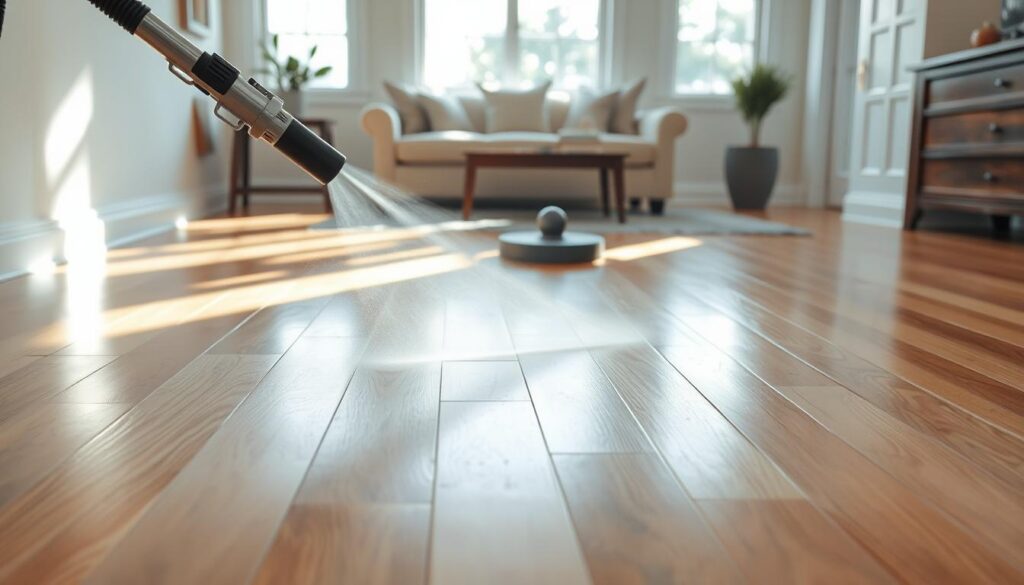
Fully Sealed Hardwood Considerations
First, check if your floor is sealed properly. Do a water droplet test by dropping water on it. If the water beads and rolls off, it’s good. Choose floors with strong polyurethane coatings, avoiding damaged spots.
Even sealed floors need careful steam use to avoid swelling.
Low-Moisture Steam Cleaning Options
Look for steam cleaners like the Bissell SteamClean Pro or Shark Steam Mop, made for wood. They should have:
- Adjustable temperature controls (below 200°F)
- Microfiber pads to soak up extra moisture
- Moisture sensors to watch the moisture level
When steam cleaning, move the mop in straight lines without stopping. Test it on a hidden spot first. Use it only once a month and never on unsealed floors. Choose products that are safe for hardwood.
Expert Opinions: What Flooring Professionals Say
Flooring experts have different opinions on steam cleaning hardwood floors. The expert-approved steam cleaning for hardwood floors depends on the type of wood and its finish. Companies like Armstrong and Mohawk often advise against using high heat. Yet, professional cleaners suggest using controlled methods.
“Steam can be safe if used at 130°F or below, but DIYers often misuse it,” says Linda Carter, a NWFA-certified restorer. Industry groups like the Floor Covering Institute agree: improper steam use voids warranties for 68% of floor brands.
Experts say it’s best to hire certified technicians for should you hire steam cleaning services for wood floors?. Professional services use low-moisture devices and keep an eye on humidity levels. A 2023 survey by the National Wood Flooring Association found 75% of pros recommend hiring specialists over DIY to avoid warping.
- Manufacturers: 80% prohibit steam in user manuals
- Restoration experts: 60% endorse trained technicians
- Industry consensus: Always check floor type and warranty terms
When thinking about steam cleaning, get a professional’s opinion first. Flooring associations suggest checking manufacturer guidelines before starting. Professional services use equipment that’s right for the wood species and finish.
Best Practices If You Choose to Steam Clean Hardwood

When you decide to steam clean your hardwood floors, it’s important to do it right. Follow these steps to keep your floors clean and safe.
Recommended Temperature Settings
Make sure your steam cleaner isn’t too hot. Most experts say to keep it between 180°F–200°F. This heat is enough to clean without soaking the wood.
Check your steam cleaner to see if you can adjust the temperature. Some models can’t be changed and might be too hot. Always check with the manufacturer to make sure it’s safe for your floor.
- Set your steam cleaner to the lowest temperature it can go.
- Don’t wet the floor before cleaning. Too much water can damage it.
Movement Techniques and Speed
Move the steamer quickly and smoothly. This helps prevent too much moisture from staying on the floor. Try to cover each area in 20–30 second intervals.
- Use a figure-8 pattern to make sure you cover everything evenly.
- Clean in sections of 2–3 feet before drying with a microfiber cloth.
- Keep your speed steady. Moving too slow can leave too much moisture, while moving too fast can be too harsh.
Frequency Limitations
Don’t steam clean your floors too often. It’s best to do it 1–2 times a year. Cleaning too much can damage the finish or even warp the wood.
Compare steam cleaning to other methods:
| Method | Recommended Frequency |
|---|---|
| Steam Cleaning | Every 3–6 months |
| Damp Mopping | Monthly |
| Dry Sweeping | Weekly |
Always dry your floors well after cleaning. Use fans or open windows. The best way to steam clean hardwood floors is to be careful and not overdo it.
Engineered Hardwood vs. Solid Hardwood: Steam Cleaning Differences
Choosing to steam clean your hardwood floors depends on the type of flooring. Engineered and solid hardwood have different constructions. This affects how well they handle steam cleaning.
Why Engineered Hardwood Might Be More Resilient
Engineered planks have layers that spread out stress and moisture. Brands like Armstrong Flooring and Pergo make engineered floors with waterproof cores. Their design makes them less likely to warp than solid wood:
- Cross-ply layers block moisture penetration
- Manufacturers like Mohawk approve steam at ≤200°F
- 6mm+ wear layers handle steam better than thinner planks
Special Considerations for Solid Hardwood
Solid hardwood absorbs moisture unevenly because it’s made from one piece of wood. Species like oak and hickory can swell and crack when exposed to steam. It’s important to have 1/8″ expansion spaces to prevent steam from getting into the subfloor. Brands like Teragren say you shouldn’t steam clean solid planks.
| Feature | Engineered | Solid |
|---|---|---|
| Moisture Tolerance | Stable due to layered construction | High expansion risk |
| Steam Temperature Limits | Up to 212°F if sealed | 0°F (no steam) |
| Warranty Coverage | Some warranties cover low-moisture steam | Most exclude steam-related damage |
Bruce Hardwood’s guides say engineered floors with HDF cores can handle steam better than solid oak. Always check the manufacturer’s guidelines before steam cleaning your floors.
Alternative Cleaning Methods for Hardwood Floors
Looking for safe ways to clean hardwood floors without steam? There are proven alternative methods to clean hardwood floors that protect the wood’s finish. These methods keep your floors clean without the risk of moisture damage. You can use tools like microfiber mops and pH-balanced cleaners to maintain your floors effectively.
- Microfiber mopping with a damp mop and water or specialized cleaners
- Vacuuming with a soft-bristle attachment to remove dust and grit
- Spot-cleaning spills with a damp cloth and mild soap
- Regular dry mopping with a microfiber pad to prevent scratches
A damp mop is best when it’s slightly wrung out. Too much water can harm your floors, so keep the mop almost dry. Products like Bona Hardwood Floor Cleaner or Swiffer WetJet are safe for finishes. They clean well without leaving residue or excess moisture.
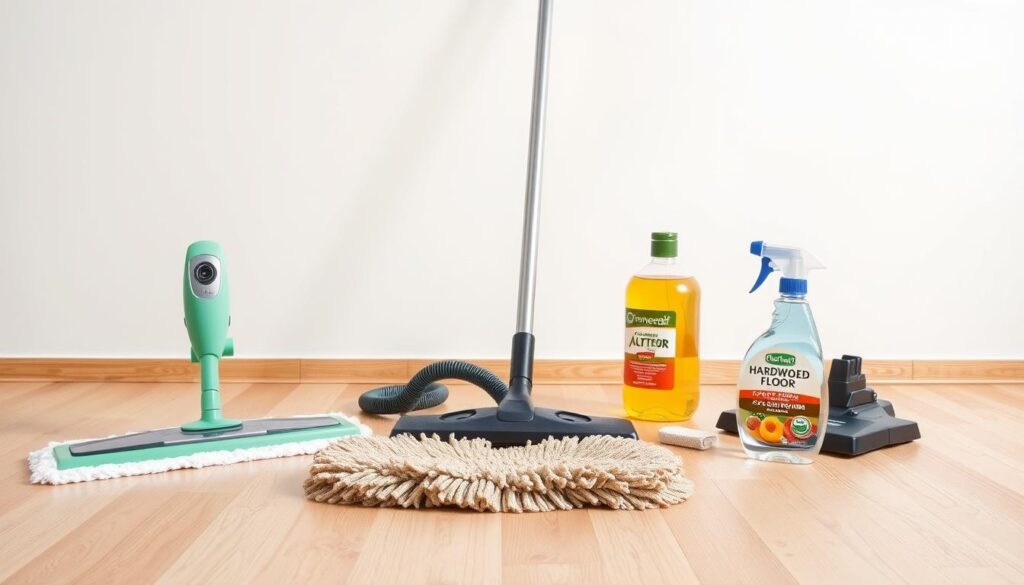
Regular maintenance with these methods keeps your floors clean and extends their life. They offer reliable how to maintain hardwood floors without steam by controlling moisture and using gentle techniques. These strategies are perfect for daily upkeep and spot cleaning without risking damage.
Safe and Effective Cleaning Products for Hardwood
Protecting your hardwood floors starts with the right cleaning products. Safe cleaning products for hardwood floors keep them looking good and lasting longer. Here’s how to pick and use them right.
pH-Balanced Cleaners
Use cleaners with a pH between 6-8.5 to keep your wood floors safe. These cleaners won’t harm the finish. Look for products labeled as “pH-neutral” or “wood-safe.” Stay away from cleaners that are too acidic or alkaline.
Specialized Hardwood Floor Products
- Oil-based finishes need gentle, oil-free cleaners to avoid damage.
- Polyurethane finishes can handle stronger cleaners but need rinsing to avoid residue.
- Don’t use ammonia or bleach, as they can harm wood fibers over time.
Homemade Solutions That Won’t Damage Wood
Try these alternative methods to clean hardwood floors:
- Water and Microfiber Cloth: Clean spills right away with a dry or slightly damp cloth.
- Vinegar Mix: Mix 1/4 cup white vinegar with 1 gallon water. Mop gently and dry well.
- Tea Solution: Cool brewed black tea can be used as a mop. It enhances the wood’s natural color.
Stay away from oil-based cleaners like olive oil, as they attract dirt. Always test a new product on a small area first.
Maintenance Routines to Keep Hardwood Floors Clean Without Steam
Having a regular care plan stops dirt from building up. This makes how to maintain hardwood floors without steam easy. Begin by sweeping daily with a soft broom or a microfiber dust mop. This removes grit that can scratch the floors.
Don’t use wet mops unless you’re using cleaners like Bona or Method’s wood-safe formulas. These are safe for your floors.
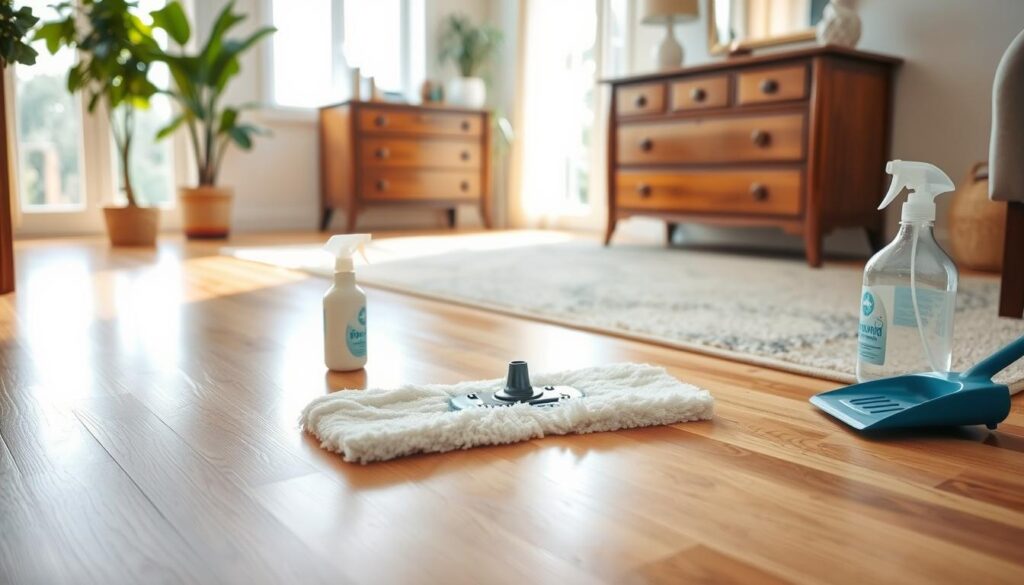
- Weekly: Damp mop with a 1:10 water-cleanser mix, wringing the cloth until dripping stops.
- Monthly: Polish with a dry microfiber pad attached to a Swiffer-style tool to lift dust without moisture.
- Seasonal: Deep-clean stains with a paste of baking soda and lemon juice, rinsed immediately.
| Household Challenge | Alternative Methods |
|---|---|
| Pets | Use lint rollers on rugs daily to trap fur before it embeds. |
| Children | Install anti-slip rugs in play areas to trap crumbs and reduce spills. |
| High Traffic | Place doormats at entries to trap 80% of dirt before it enters, per National Floor Safety Institute data. |
Alternative methods to clean hardwood floors work best with regular use. Clean spills right away with a dry cloth. This prevents damage from too much liquid.
Change furniture pads every 6 months to avoid dents. These steps help keep your floors clean without the danger of steam. With these steps, cleaning becomes a quick weekly task, not a big job.
When to Consider Professional Hardwood Floor Cleaning
Deciding to hire steam cleaning services for wood floors depends on your floor’s condition and cleaning needs. Steam cleaning can be effective if done right. But, some situations need professional help. Homeowners should check if DIY cleaning is enough or if they need advanced methods to protect their floors.
Deep Cleaning Services Available
Professional services use advanced methods like screen-and-recoat processes. These sand and refinish worn surfaces. Buffing and specialized steam systems remove deep grime without harming finishes.
These techniques are perfect for engineered or solid hardwood. They tackle issues beyond basic cleaning. Some providers use pH-balanced solutions to prevent finish damage, offering better results than DIY tools.
Cost Comparison: Professional vs. DIY
Professional cleaning costs $200–$500, based on floor size and complexity. DIY steam cleaning kits start at $50 but need skill to avoid damage. DIY is good for routine upkeep, but pros are best for heavy dirt, damaged finishes, or big spills.
High-end wood flooring may need professional care to keep its value and warranty. Choosing the right method depends on budget, skill, and floor condition. If unsure, a certified flooring technician can ensure safe, long-term care that follows manufacturer guidelines.

